In fluences of Crystal-Field and Interlayer Coupling Interactions on Dynamic Phase Diagrams of a Mixed-Spin(3/2,2)Bilayer System∗
Mustafa Keskin and Yusuf Ko¸cak
Physics Department,Erciyes University,38039 Kayseri,Turkey
1 Introduction
Magnetic properties of thin magnetic films with magnetic-layered structures have been the subject of intense experimental and theoretical researches due to their great potential for technological applications,such as electronic semiconductor devices,optical coatings,computer memory,protection of substrate materials against corrosion,oxidation and wear.[1]Many works have been experimentally investigated on the magnetic properties of the bilayers and multilayers thin films,such as Co/Pt,Pt/Co/Pt,Pt/Co/AlOx,Gd-Co/Ti,W/B4C,CoSiB/CSiB,Cd/Pd,Ni-Zr,Ni/Ti,Fe/Ni,Fe/Co,Ni/Au,Co/Cu/Ni80Fe20,La2/3Ca1/3MnO3/SrTiO3/YBa2Cu3O7−x,FePt/Fe,and Fe/TbFe etc.(see Refs.[2–17]and references there in).Theoretically,the spin-1/2(see Refs.[18–30]and references therein),spin-1(see Refs.[31–35]and references there in)and also mixed Ising systems,namely spin(2,5/2),[36−37]spin(1,3/2),[38]spin(3/2,2)[39]and spin(3/2,5/2),[40]have been used to study magnetic behaviors of the bilayers and multilayers thin films within the methods of the equilibrium statistical physics.Moreover,the bilayer spin-1,[41]spin-3/2,[42]spin[43]as well as mixedspin[44−45]systems on the Bethe lattices have been also investigated to observe some magnetic properties of thin films.Dynamic magnetic properties of thin films have been examined by using the spin-1/2,[46−50]spin-1,[51−53]mixed-spin(2,5/2),[54−55]mixed-spin(3/2,2)[56−58]bilayer systems.In recent years,magnetic phase diagrams of ferrimagnetic mixed-spin system have been studied comprehensively(see Refs.[59–61]and references therein).
In spite of these studies,the dynamic magnetic critical properties of bilayer systems have not been investigated in detail.In particular,the crystal- field interaction,in which one of the important interaction parameter,either taken as zero or taken as same(D)forAandBsublatices in all these studies,except Ref.[57].In Ref.[57],the crystalfield interaction for sites onAlattice asDAand for sites onBlattice asDBwere taken and only the dynamic phase diagrams(DPDs)in ferromagnetic spin(3/2,2)bilayer system was investigated.In this paper,in fluences of crystalfields(DAandDB)and interlayer coupling interactions(J3)on dynamic magnetic behaviors of a mixed-spin(3/2,2)bilayer system under a time-dependent magnetic field are investigated by the Glauber-type stochastic(GTS)dynamics based on the mean- field theory(MFT)in detail.For this aim,the DPDs are presented in the reduced temperature(T)and magnetic field amplitude(h)plane for the ferromagnetic/ferromagnetic(FM/FM),antiferromagnetic/ferromagnetic(AFM/FM)and AFM/AFM interactions.The effect of theDA,DBas well asJ3,which is related to the thickness,on the critical behaviors of the system are extensively studied and discussed.
2 Model and Formulation

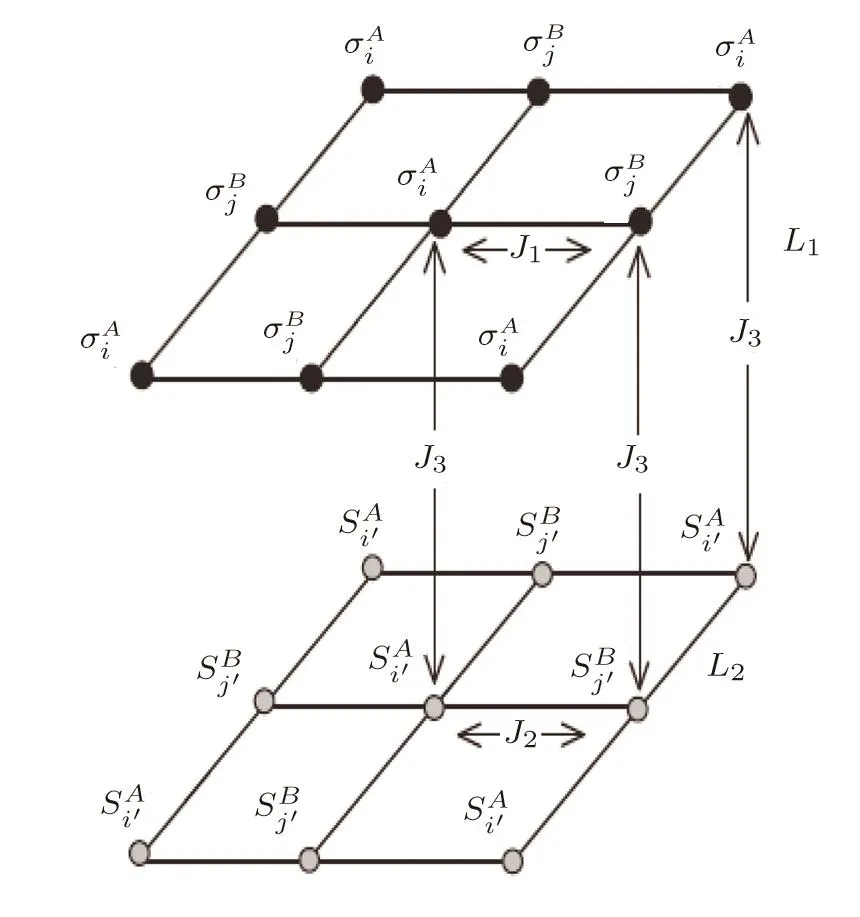
Fig.1 Schematic representation of a two-layer square lattice:L1and L2refer to the upper and lower layers containing the spins labeled as σAi,σBj,and SAi,SBj.
The Hamiltonian of the system can be given by

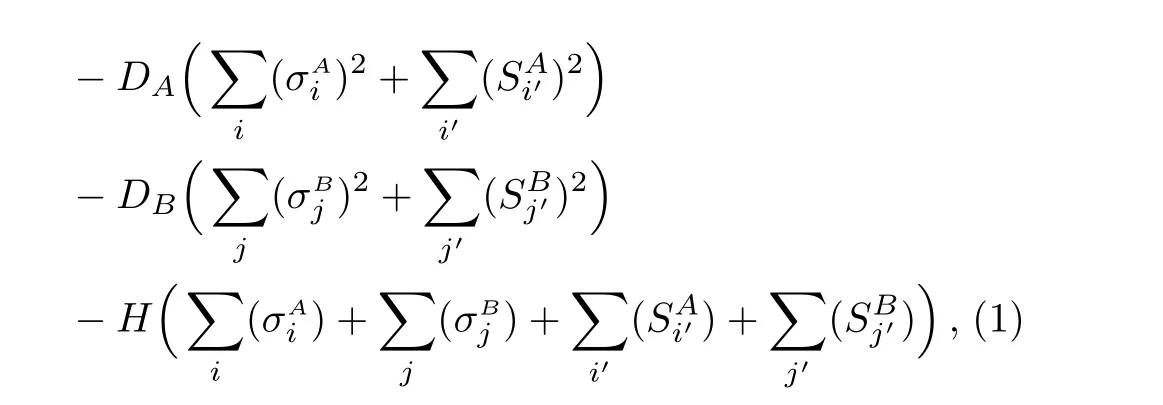
where⟨ij⟩and⟨i′j′⟩represent a summation over all pairs of the NN sites of each layer.J1andJ2are exchanging interactions for theL1andL2layers,respectively,also called intralayer coupling constants,andJ3is the interlayer coupling constant over all the adjacent neighboring sites of layers,as illustrated in Fig.1.His an external field that isH=H0cos(wt),H0,andw=2vπare the amplitude and the angular frequency,respectively.DAandDBrepresent the crystal fields for sites onAandBlattices,respectively.The system is in contact with an isothermal heat reservoir at absolute temperatureTA.


whereς=ωt,T=(βJ1)−1,h=H0/J1,dA=DA/J1and Ω =τω,z=4 andω=2πvare taken.The mean- field dynamical equation for the average magnetizations ofm1B,m2A,andm2Bcan be similarly obtained as

wheredB=DB/J1.The solutions and discussions of these mean- field dynamical equations will be given and discussed in Sec.3.In numerical calculations,we fixedJ1=1,dA=DA,anddB=DB.
3 Numerical Results and Discussion
Equations(5)–(8)were solved by the Adams-Moulton predictor-corrector method to find phases in the system for the FM/FM(J1>0 andJ2>0),AFM/FM(J1<0 andJ2>0)and AFM/AFM(J1<0 andJ2<0)interactions for the given system parameters and initial values.Since the solution of these kind of dynamic equations were presented[46,50,54−57]in detail,the solutions are not discussed and figures are not given.From these investigations we find that the system comprises,depending on system parameters,the paramagnetic(p),phases and the af+p,m+p,m+f,sf+f,sf+af mixed phases for the AFM/AFM interaction.We should also mention that since the some similar typical results for the dynamic magnetization curves for different magnetic phase states were given by Refs.[50,56,62–64],we do not present the dynamic magnetizations curves in order to avoid some overlaps.



Equation(9)was solved by combining the numerical methods of the Adams-Moulton predictor corrector with Romberg integration to obtain the dynamic phase transition(DFT)points and also to characterize the nature of the transitions.From these detail solutions and investigations we find that the system undergoes either a first-or second-order phase transitions that depending on interaction parameters;hence we also obtained the DPT points.The DPDs are given in the(T,h)planes for the FM/FM,AFM/FM and AFM/AFM interactions,seen in Figs.2–7.In the figures,the dashed and solid lines illustrate thefirst-and second-order phase transition lines,respectively.TR,A,M,andBare the dynamic tricritical,multicritical,tetracritical and critical end points,respectively.Finally,the TP represents the triple point.


Fig.2 Phase diagrams of the spin(3/2,2)Ising system on two-layer square lattice in(T,h)plane for the FM/FM interactions(J1>0 and J2>0),J1=1.0 and J2=1.0.The solid and dashed lines are the second-and first-order lines,respectively.TR,B,TP and QP represent thedynamic tricritical,dynamic critical end,triple and quadruple points,respectively.(a)J3=5,DA=0.0 and DB=0.0,(b)J3=0.25,DA=−0.5,DB=0.0;(c)J3=5,DA=0.0,DB= −0.55,(d)J3=0.25,DA= −0.5,DB= −0.25,(e)J3=5,DA= −0.25,and DB=−0.5,(f)J3=0.25,DA=−0.25,and DB=−0.5.
Figures 4 and 5 display the DPDs of the AFM/FM interactions for the repulsive(J3>0)and attractive(J3<0)interlayer coupling constant,respectively,J1=−1.0,J2=1.0 and various values ofDAandDB.From Fig.4,we have seen following interesting phenomena:(i)ForDA=DB=0,the system contains the p,f and p+f phases as well as theTRtricritical point.The dynamic phase boundaries among the p+f,f and p phases are firstorder lines but the dynamic boundary between the f and p phase is a second-order,seen in Fig.4(a).For small values ofJ3,the TP point is also observed(Fig.4(b)).(ii)ForDA/=0 andDA=0 or wise versa,the DPD is akin to Fig.2(a),except followings;A critical point and the p+f mixed phase appear for the low values of h and high values ofT,seen in Fig.4(c)and the new f+sf phase occurs at low values ofTandh.(iii)ForDA/=0 andDA/=0(Figs.4(e)and 4(f)),the phase diagrams are very similar to Fig.4(c),except theAspecial critical point and one more the p+f phase occur at high values ofTand low values ofh,seen in Fig.4(f).(iv)For small values of theJ3the sf+f mixed phase occurs at low values ofTandh,and the boundary between the sf+f mixed and f phases is a second-order phase line(Fig.4(f).The behavior of DPDs in Figs.5(a),5(c)and 5(e)are similar to Figs.4(a),4(c)and 4(e),but the difference is that the f phase transforms into the c phase.Fig.5(b)displays the same behavior as Fig.5(a),except the c phase turns to the af and the TP point and the c+af mixed phase at lowTappear.The DPD in Fig.5(d)is similar to Fig.5(b),except the reentrant behavior is observed.Fig.5(f)illustrates the same behavior as Fig.5(b),but differences are following.(i)The c+af at lowTdisappears and the new p+af phase is seen.(ii)The boundaries among the af,p+af and p phases are second-order lines.
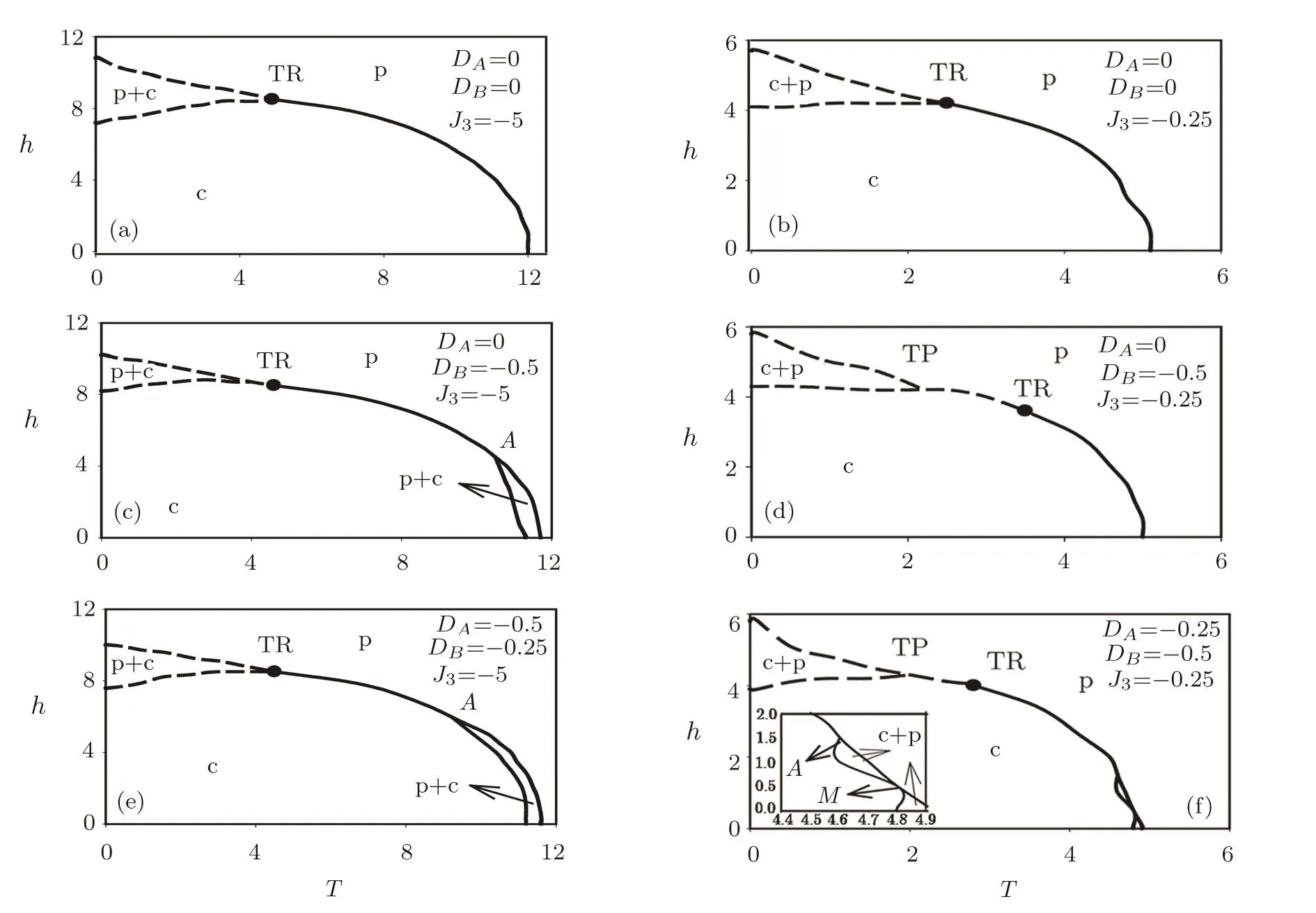
Fig.3 Same as Fig.2,but J3=−5 for(a),(c),(e)and J3=−0.25 for(b),(d),(f).The special points are the dynamic multicritical(A)and dynamic tetracritical(M)points.

Fig.4 Same as Fig.2,but for the AFM/FM interactions(J1<1.0 and J2>0),J1=−1.0,J2=1.0.J3=5.0 for(a),(c),(e)and J3=0.25 for(b),(d),(f).
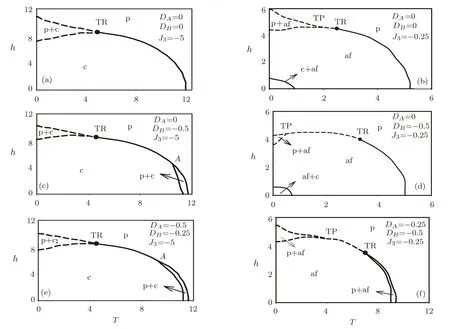
Fig.5 Same as Fig.4,but for J3=−5 for(a),(c),(e)and J3=−0.25 for(b),(d),(f).

Fig.6 Same as Fig.2,but for the AFM/AFM interactions(J1<0 and J2<0),J1=−1.0,J2=−1.0,J3=5 for(a),(c),(e)and J3=0.25 for(b),(d),(f).
Figures 6 and 7 display the DPDs of the AFM/AFM interactions for the repulsive(J3>0)and attractive(J3<0)interlayer coupling constant,respectively,J1=−1.0,J2=−1.0 and various values ofDAandDB.First of all,only Figs.6(a),6(c),6(e)display a reentrant behavior.ForDA=DB=0(Figs.6(a)and 6(b)),the system contains the p,m and p+m as well as theTRtricritical point.The f+m mixed phase occurs for high values ofJ3(Fig.6(a))and the TP point is seen for low values ofJ3(Fig.6(b)).Moreover,the dynamic phase boundaries among the p+m,m and p phases and the boundary between the f+m and m are first-order phase lines but the dynamic boundary between the m and p phase is a second-order line.Figure 6(c)is likefig.6(a),but the DPD in Fig.6(c)contains the new p+m phase and the TP,A points at high values ofT.The boundary between the m and f+m,and the boundaries among m,p+m and p are second-order lines.The DPD in Fig.6(d)displays same behavior as Fig.6(c),except the TP,A points and the p+m phase as well as the reentrant behavior do not occur.The topology of Fig.6(e)is very akin to Fig.6(c),except the p+m phase does not occur.The behavior in Fig.6(f)is very similar to Fig.6(d),except the TP point also appears.The behavior of Fig.7 is similar to Fig.6,except following two main differences:(i)The m phase turns into the c phase in Figs.7(a),7(c),7(e)and the af phase in Figs.7(b),7(d),7(f).(ii)TheTRappears for lower values ofh.

Fig.7 Same as Fig.6,but J3=−5 for(a),(c),(e)and J3=−0.25 for(b),(d),(f).
In conclusion,we study in fluences of crystal- fields(DAandDB)and interlayer coupling(J3)interactions on the DPDs of the mixed-spin(3/2,2)bilayer system for the FM/FM,AFM/FM,and AFM/AFM cases in the presence of a time-varying magnetic field within the GTS dynamics based on the MFT.We investigate the in fluence of theDA,DBas well asJ3on the DPDs and find that their effects on the dynamic magnetic critical properties of the DPDs more for the FM/FM,AFM/FM interactions,but less for the AFM/AFM.In particular,the sign and magnitudes ofJ3are mostly effect the phases in the system and theDAandDBmostly affect the critical behavior of the DPDs.Finally,it is worthwhile to mention that the mixed-spin(3/2,2)bilayer system also shows the compensation behavior as the other mixed-spin bilayer systems[59−63,65]that the comprehensively study should be worked out.
[1]K.N.Chopra and A.M.Maini,Thin Films and Their Applications in Military and Civil Sectors,DRDO Monographs/Special Publications Series,New Delhi(2010)India.
[2]M.S.Wang,Y.Ji,S.L.Luo,et al.,Materials Science in Semiconductor Processing.51(2016)55.
[3]M.Bersweiler,K.Dumesnil,D.Lacour,and M.Hehn,J.Phys.Condens.Mat.28(2016)336005.
[4]M.Charilaou,C.Bordel,P.E.Berche,et al.,Phys.Rev.B 93(2016)224408.
[5]R.Mansell,A.Mizrahi,A.Benguivin,and R.P.Cowburn,IEEE Transactions on Magnetics 52(2016)2002904.
[6]J.J.Jin,S.H.Oh,and W.Jo,J.Physics D-Applied Physics 49(2016)125305.
[7]A.V.Svalov,G.V.Kurlyandskaya,V.O.Vaskovskiy,et al.,Superlattices and Microstructures 90(2016)242.
[8]H.Jiang,S.Yan,J.T.Zhu,et al.,Appl.Surf.Sci.357(2016)1180.
[9]S.Jung,T.Kim,and H.Yim,J.Nanosci.Nanotechno.15(2015)8739.
[10]M.Je,H.Choi Y.Wang,et al.,Thin Solid Films 589(2015)252.
[11]K.C.Kuiper,T.Roth,A.J.Schellekens,et al.,Apply.Phys.Letts.105(2014)202402.
[12]H.Turnow,H.Wendrock,S.Menzel,et al.,Thin Solid Films 561(2014)48.
[13]T.Veres,L.Cser,V.Bodnarchuck,et al.,Thin Solid Films 540(2013)69.
[14]G.P.Zhang,X.Q.Wang,G.H.Lu,et al.,Chin.Phys.B 22(2013)035204.
[15]K.W.Chou,A.Puzic,H.Stoll,et al.,J.Appl.Phys.99(2016)08F305.
[16]L.S.Huang,J.F.Hu,and J.S.Chen,J.Magn.Magn.Mater.324(2012)1242.
[17]Z.Cao and X.Zhang,J.Appl.Phys.39(2006)5054.
[18]H.Magoussi,A.Zaim,and M.Kerouad,Superlattices Microst.89(2016)188.
[19]E.Kantar,J.Supercond Nov Magn.28(2015)3387.
[20]E.Kantar,Chin.Phys.B 24(2015)107501.
[21]D.S.Sabogal,J.D.D.Alzate,and E.P.Restrepo,Physica A 434(2015)60.
[22]Y.Yuksel,J.Magn.Magn.Mater.385(2015)47.
[23]T.Kaneyoshi,J.Magn.Magn.Mater.339(2015)260.
[24]T.Kaneyoshi,Phase Transit.88(2015)121.
[25]N.S¸arli,S.Akbudak,and M.R.Ellialtiolu,Physica B 452(2014)18.
[26]T.Mayberry,K.Tauscher,and M.Pleimling,Phys.Rev.B 90(2014)011438.
[27]J.Jiang,J.N.Chen,B.Ma,and Z.Wang,Physica E 61(2014)101.
[28]T.Kaneyoshi,J.Magn.Magn.Mater.336(2013)8.
[29]Z.X.Lu,B.H.Teng,and X.H.Lu,Solid State Commun.149(2009)1176.
[30]E.A.Jagle,Phys.Rev.B 72(2005)094406.
[31]A.Jabar,A.Belhaj,H.Labrim,et al.,J.Supercond Nov Magn 28(2015)2721.
[32]A.Jabar,A.Belhaj,H.Labrim,et al.,Superlattices Microst.78(2015)171.
[33]E.Kantar and M.Erta¸s,Solid State Commun.188(2014)71.
[34]Y.Yuksel,Physica B 436(2014)1.
[35]N.Tahiri,H.Ez-Zahraouy,and A.Benyoussef,Chin.Phys.B 20(2011)017501.
[36]N.De La Espriella,C.A.Mercado,and G.M.Buendia,J.Magn.Magn.Mater.417(2016)30.
[37]W.Wang,W.Jiang,D.Lv,and F.Zhang,J.Phys.D 45(2012)475002.
[38]A.Feraoun,A.Zaim,and M.Kerouad,J.Supercond Nov Magn 29(2016)971.
[39]B.Deviren,Y.Polat,and M.Keskin,Chin.Phys.B 2(2011)060507.
[40]B.Ma and W.Jiang,IEEE Transactions on Magnetics 47(2011)3118.
[41]O.Canko and E.Albayrak,Phys.Rev.E 75(2007)011116.
[42]E.Albayrak,S¸.Yilmaz,and S¸.Akkaya,J.Magn.Magn.Mater.310(2007)98.
[43]E.Albayrak,S¸.Akkaya,and S¸.Yilmaz,Int.J.of Mod.Phys.B 22(2008)4877.
[44]E.Albayrak and S¸.Yilmaz,Physica A 387(2008)1173.
[45]E.Albayrak,S¸.Akkaya,and S.Yilmaz,J.Physics-Condensed Matter 19(2007)376212.
[46]M.Erta¸s,E.Kantar,and M.Keskin,J.Magn.Magn.Mater.358(2014)56.
[47]E.Vatansever and H.Polat,Thin Solid Films 589(2015)778.
[48]B.O.Akta¸s,U.Akinci,and H.Polat,Phys.Rev.E 90(2014)012129.
[49]B.O.Akta¸s,U.Akinci,and H.Polat,Thin Solid Films 562(2014)680.
[50]E.Kantar,Phase Transit.89(2016)971.
[51]M.Erta¸s,Mod.Phys.Lett.B 29(2015)1550236.
[52]K.I.Mazzitello,J.Candia,and E.V.Albano,Phys.Rev E 91(2015)042118.
[53]Y.Yuksel,Phys.Lett.A 377(2013)2494.
[54]M.Erta¸s and M.Keskin,Chin.Phys.B 22(2013)120506.
[55]M.Erta¸s and M.Keskin,Phys.Lett.A 376(2012)2455.
[56]u.Temizer,M.Tulek,and S.Yarar,Physica A 415(2014)156.
[57]M.Erta¸s,Y.Ko¸cak,and M.Keskin,Conferences of the International Journal of Arts-Sciences.09(2016)145.
[58]M.Keskin and M.Erta¸s,J.Supercond Nov Magn.30(2017)3439.
[59]W.Wang,F.L.Xue,and M.Z.Wang,Physica B 515(2017)104.
[60]D.Lv,F.Wang,R.J.Liu,and S.X.Li,Journal of Alloys and Compounds 701(2017)935.
[61]W.Wang,D.Lv,J.L.Bi,and J.N.Chen,J.Magn.Magn.Mater.385(2015)16.
[62]u.Temizer,M.Keskin,and O.Canko,J.Magn.Magn.Mater.321(2009)2999.
[63]M.Keskin,B.Deviren,and O.Canko,IEEE Transactions on Magnetics 45(2009)2640.
[64]B.Deviren and M.Keskin,J.Stat.Phys.140(2011)934.
[65]B.Deviren,S.Akbudak,and M.Keskin,Solid State Commun.151(2011)193.
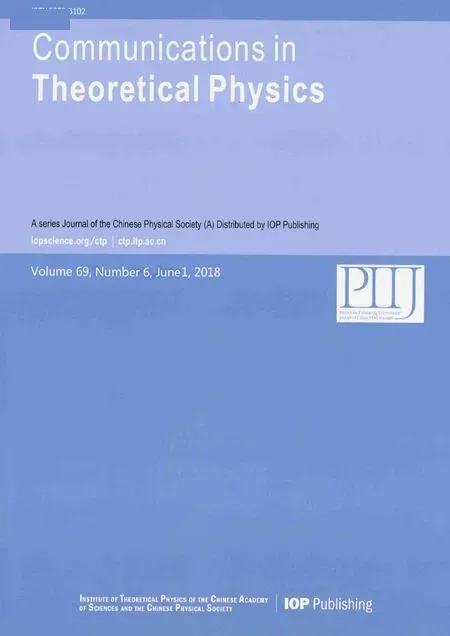 Communications in Theoretical Physics2018年6期
Communications in Theoretical Physics2018年6期
- Communications in Theoretical Physics的其它文章
- Spontaneous Emission Originating from Atomic BEC Interacting with a Single-Mode Quantized Field
- Destroying a Near-Extremal Kerr-Newman-AdS Black Hole with Test Particles∗
- Ordinary Mode Instability in a Cairns Distributed Electron Plasma
- Thermal Conductivity of Complex Plasmas Using Novel Evan-Gillan Approach
- Statistical Properties of a System Consisting of a Superconducting Qubit Coupled to an Optical Field Inside a Transmission Line
- Molecular Dynamics Simulations of the Elastic Anisotropy of Pd at Extreme Conditions∗
